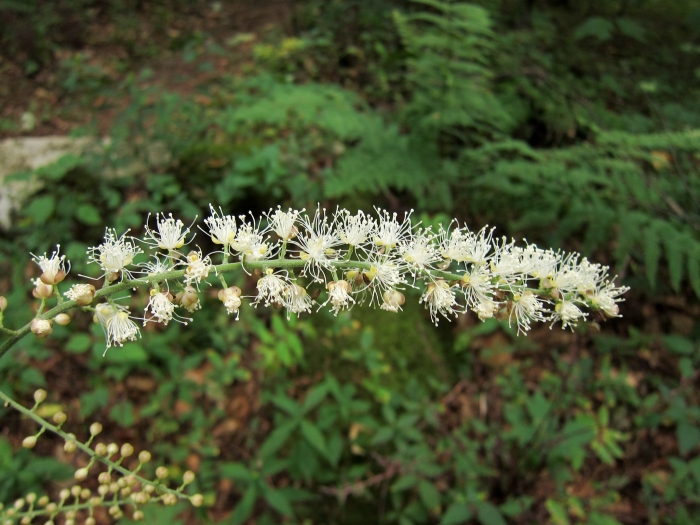Mountain Bugbane
(Actaea podocarpa)
Mountain Bugbane (Actaea podocarpa)
/
/

Miguel Vieira
CC BY 4.0
Image By:
Miguel Vieira
Recorded By:
Copyright:
CC BY 4.0
Copyright Notice:
Photo by: Miguel Vieira | License Type: CC BY 4.0 | License URL: http://creativecommons.org/licenses/by/4.0/ | Rights Holder: Miguel Vieira | Publisher: iNaturalist | Date Created: 2011-09-11T11:55:42-07:00 |

























Estimated Native Range
Summary
Actaea podocarpa, commonly known as Mountain Bugbane or Mountain Black Cohosh, is a perennial herb native to the rich, mesic forests of the Appalachian Mountains, with a notable disjunct population in Illinois. It thrives in the understory of deciduous woodlands, often found in boulder-strewn coves and ravines, which provide a moist, shaded environment. Mountain Bugbane typically grows to a height of 4-6 feet (1.2-1.8 meters) with a similar spread. It features compound leaves and produces tall, wand-like racemes of small, creamy white flowers from late summer to fall, which are moderately showy and attract pollinators.
The plant is valued for its ornamental foliage and the vertical accent provided by its flower spikes. It is used in shaded garden borders, woodland gardens, and naturalized areas. Mountain Bugbane prefers partial to full shade, consistent moisture, and well-drained, humus-rich soil. It is relatively low maintenance but requires adequate space to accommodate its spread. While it is sometimes confused with black cohosh (Actaea racemosa) and harvested for similar medicinal uses, it is important to correctly identify the species to ensure proper use. Mountain Bugbane can be susceptible to leaf spot and rust, particularly in humid conditions.CC BY-SA 4.0
The plant is valued for its ornamental foliage and the vertical accent provided by its flower spikes. It is used in shaded garden borders, woodland gardens, and naturalized areas. Mountain Bugbane prefers partial to full shade, consistent moisture, and well-drained, humus-rich soil. It is relatively low maintenance but requires adequate space to accommodate its spread. While it is sometimes confused with black cohosh (Actaea racemosa) and harvested for similar medicinal uses, it is important to correctly identify the species to ensure proper use. Mountain Bugbane can be susceptible to leaf spot and rust, particularly in humid conditions.CC BY-SA 4.0
Plant Description
- Plant Type: Herb
- Height: 3-8 feet
- Width: 2-4 feet
- Growth Rate: Slow
- Flower Color: White
- Flowering Season: Summer, Fall
- Leaf Retention: Deciduous
Growth Requirements
- Sun: Part Shade, Full Shade
- Water: Medium
- Drainage: Medium
Common Uses
Bee Garden, Bird Garden, Butterfly Garden, Low Maintenance, Water Garden
Natural Habitat
Rich, mesic forests of the Appalachian Mountains, including boulder-strewn coves and ravines
Other Names
Common Names: Mountain Bugbane, Yellow Cohosh, Summer Cohosh
Scientific Names: , Actaea podocarpa, Actaea americana, Actaea cordifolia, Actaea pentacarpa, Actaea pentacarpa, Actaea pentagyna, Cimicifuga americana, Cimicifuga cordifolia, Cimicifuga cordifolia
GBIF Accepted Name: